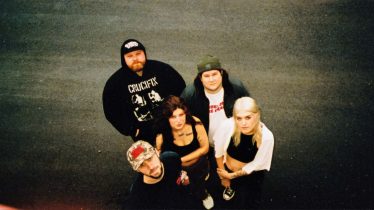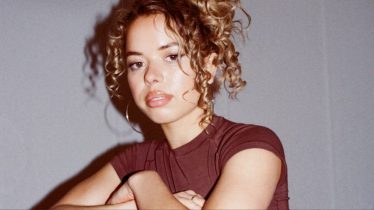![[Photos: Rites Of Spring by Roberto Queiroz, Cap'n Jazz by Steven Wade, Dashboard Confessional by Phil Mucci, Lil Peep]](https://www.altpress.com/wp-content/uploads/2018/06/01/emo_history_defined-1052x592.jpg?t=1689351121)
What is emo, anyway? We look at history to define a genre
Emo. All of us have heard, embraced, quoted and lived by the music. Many of its practitioners have welcomed and flat out rebuked the term. But nobody has really nailed down a diehard definition of “emo.” Until now.
What does “emo” even mean, yo? All music is emotional, bruh!
Well, sure, I guess. Bruno Mars makes us happy. The Chainsmokers give us secondhand embarrassment. And like every red-blooded American, we sob our way through Celine Dion’s greatest hits on a regular basis.
But that’s not what we’re talking about here. Because when we refer to “emo,” we’re talking about something specific, even if we have a little trouble putting our finger on what exactly it is. So, does emo actually mean something? And if so, who gets to decide? What the heck do Lil Peep, the Used and Sunny Day Real Estate have to do with each other, anyway?
The good news is we can help you with answers to these questions. Because if you understand how emo started, and how it got to here, the questions actually start to answer themselves.
There’s a general consensus that the “emo” begins with the formation in 1984 of Rites Of Spring. Barreling forth from Washington D.C.’s hardcore scene, Rites Of Spring were every bit as fiery and clamorous as their peers, but where most of their compatriots raged against the world around them, frontman Guy Picciotto turned his gaze inward, rejecting the D.C. scene’s righteous aggression in favor of an equally forceful vulnerability, interrogating his own emotions like a bad cop with a perp in a dark room.
Rites Of Spring’s impact was immediate—their formation was followed quickly by the similarly-minded Embrace, led by scene legend/Dischord Records founder/former Minor Threat frontman Ian MacKaye, kickstarting what’s become known as the “Revolution Summer,” a wave of creative experimentation that washed over the D.C. hardcore scene in 1985. (Picciotto and MacKaye would later combine forces in the supremely influential post-hardcore band Fugazi, where their radical reimagining of hardcore’s musical boundaries—and their strident anti-commercial stances—would inform virtually every genre of underground music, from politically-minded crust punk to highfalutin indie rock.)
Nobody can seem to agree on who first called these bands “emo” (or “emocore,” or “emotional hardcore”), or which band was the first to be slapped with the label. What everyone does seem to agree on, though, is that it was meant as an insult from the start, and no band wanted anything to do with the moniker. (This, perhaps more than anything else, is the one quality that unites emo bands from 1985 straight through today.) Nevertheless, it stuck.
As far back as the early ’90s, the term “emo” was plastic, one that stretched and changed shape as it was applied to different bands from different corners of the underground. At the time, it was more of an adjective than a genre name, a descriptor applied to underground bands of all sorts of stripes. In that pre-internet era, local scenes were often insular, and it often seemed each city had its own idea of what “emo” might be.
In San Diego, bands like Antioch Arrow and Swing Kids seized on the sounds Rites Of Spring pioneered and ratcheted them to the next level of violent, chaotic intensity. Hallmarked by spastic yelping and corruscating howls, the genre known as “screamo” quickly spread east as well, where it would become a major influence on the basement show scene up and down the coast.
Further north, in Seattle, the heavily hyped Sunny Day Real Estate welded the suddenly-everywhere sounds of grunge and alternative rock to sweeping melodrama and searching lyrics, with enigmatic frontman Jeremy Enigk’s strained falsetto setting the band in stark contrast to the baritone yarlers who dominated the era and influencing a generation of emo vocalists to come. (Often pegged to be the “next Nirvana” by industry insiders, SDRE instead fractured in 1995, with the rhythm section of bassist Nate Mendel and drummer William Goldsmith moving on to form the first incarnation of the Foo Fighters with Dave Grohl of…Nirvana. So, destiny fulfilled. Kind of.)
Meanwhile, in San Francisco, as a pop-punk scene featuring the wildly hooky likes of Green Day and Rancid exploded into national prominence, the scruffy Jawbreaker injected the toughness of hardcore and the soul-baring lyricism of the Revolution Summer into pop punk’s sound, with Blake Schwarzenbach’s heart-on-ragged-sleeve tales of romantic longing and intense self-criticism setting emo’s topical tone going forward.
And while it’s a stretch to call Weezer an emo band—Rivers Cuomo, a one-time teenage metalhead with near-psychotic dedication to the art of deconstructing pop perfection, aimed his outfit toward mainstream success from their earliest days and has never shown much interest in emo at any step along the way—their influence on what emo would become is undeniable. The self-immolating personal revelations and dorky, introverted charm of the Weezer’s first two albums, along with Cuomo’s fashion sense (blocky glasses, sweaters and a bad case of bedhead), would quickly be absorbed into the fledgling genre’s DNA.
Still, it wasn’t until the late 1990s that emo as a genre really came into its own. Emo spread from the coastal metropolises to the country’s great middle. Bands began to interact more, linking together chains of friendly VFW halls and punk house basements into an alternative touring network. Record labels such as Jade Tree and Deep Elm, whose Emo Diaries compilations document the sonic diversity of the emo scene, became hubs where fans of one act could find like-minded outfits. Emo began to coalesce, with city scenes forming a national scene in the late ’90s in what’s become known as emo’s “second wave.”
There’s no strict dividing line between the first and second waves of emo, but you wouldn’t be wrong to draw it right across the top of what is no doubt the most influential group of middle school kids to hit the emo scene, Chicago’s Cap’n Jazz. Their chaotic, kitchen-sink take on the genre remains an underground inspiration to this day, but more important is what happens after they broke up: Band leader Tim Kinsella goes on to form the wonky, mathy indie rock outfit Joan Of Arc. Meanwhile, his brother, drummer Mike Kinsella, drops the sticks to front the gorgeously wistful, confessional American Football. And guitarist Davey Von Bohlen launches from here into the burst-and-bloom romantic indie pop of the Promise Ring. There isn’t much sonically that ties these three acts together, yet with their shared origin story, overlapping fanbases and similarly broadly emotional takes on matters of the heart, all three become linchpins for emo as a genre.
It’s an early affirmation that emo, at its core, isn’t a particular sound or a style but rather a legacy, a chain of influences and personal ties. Illinois’ Braid, their music full of herky-jerky sonic twists; Austin’s Mineral and their albums of intense longing; New Jersey’s Saves The Day, with their frighteningly creative lyrical invective; Arizona’s Jimmy Eat World, exuding sweetness with a sigh—all are embraced by the burgeoning emo scene of the late ’90s. And when the dream of the alternative ’90s goes up in literal flames alongside Woodstock ’99 and its mook-rock-dominated stages, leaving TRL’s roving gangs of airbrushed pop avatars to dominate the airwaves, what’s been bubbling underground quickly rushes in to fill the vacuum.
By 2002, the scene is faced with a new question: Is being underground a necessary component of emo? Bands like Thursday and At The Drive-In, born and bred in the basement punk and screamo scenes of New Jersey and Texas, respectively, find their videos breaking into regular rotation at a time when TV stations still air music videos and people still tune in to watch them. Dashboard Confessional (at the time a side project for Further Seems Forever frontman Chris Carrabba), becomes an alternative radio staple with “Screaming Infidelities.” Jimmy Eat World, their emo bona fides unimpeachable, see their single “The Middle” become a legitimate mainstream hit, not only topping the alternative charts, but even cracking the Top 10 on pop radio.
One thing about all of those bands: They all sound wildly different from one another. The sonic palette of emo is widening as quickly as outside influences can be embraced. Carrabba and Bright Eyes’ Conor Oberst (late of ’90s emo outfit Commander Venus) begin a lineage of acoustic-heavy singer-songwriter emo. Coheed And Cambria merge emo with sci-fi fantasy and prog-rock instrumental wizardry, opening up a new lane for pyroclastic guitar heroics and expansive composition under emo’s umbrella. Bands such as the Anniversary and the Faint welcome synthesizers to the party. And in Orange County, acts like Atreyu, Eighteen Visions and Avenged Sevenfold fuse the sound of SoCal’s screamo and hardcore scene with metal influenced by acts like Sweden’s At The Gates in a style that quickly gets dubbed “fashioncore” over those acts’ penchants for eyeliner, flat-ironed bangs, skin-tight tees and white belts.
All this has the purists rankled. Emo records pop up in stores like Hot Topic, costing devotees a lifetime’s-worth of scene points. Websites pop up like zits on seventh graders’ foreheads, shouting to whoever will listen that much like punk rock in 1979, “emo” is already dead. Horrified that the “screamo” tag is now being slapped on bands like the Used and Senses Fail just because they feature unclean vocals, followers of the older, more underground sound go as far as to start referring to their bands by the ultra-lulzy appellation “skramz” instead. None of it matters. In 2002, emo is a mainstream phenomenon, whether the purists like it or not.
If emo in 2002 was a bubbling mainstream phenomenon, by 2005, it’s a commercial force. Emo outfits dominate the once punk-centric Warped Tour. The Bamboozle proves that emo is big enough to build an entire festival around. It’s 20 years since the Revolution Summer, and if anyone’s trying to sound like Rites Of Spring, they probably want nothing to do with all this.
Yet the links can be traced backward as strongly as ever. My Chemical Romance sell out large venues with an act that balls up the stage-straddling bombast of Queen with the aggressive danger of their mentors Thursday and the dark dramatics of Philadelphia vampire punks Ink & Dagger. Fall Out Boy—whose members share deep ties to Chicago’s hardcore scene—top the charts with a sound that borrows wholesale from melodic hardcore pioneers Lifetime and forgotten pop-punks the Stereo. Underoath, already a long-running emo/post-hardcore act at the time, find their 2004 record They’re Only Chasing Safety picking up steam upon re-release, eventually going Gold and opening the door to the mainstream for a bevy of Christian bands.
Each generation of emo takes something from the last. In 2005, it’s the bright hooks, the gray poses and (especially) the jet black hair and eyeliner. Spread via the internet, the suburban “mall-punk” look becomes as part-and-parcel to emo as its heartrending poses. Indeed, the look and the sound that have come to characterize emo in this era becomes a much stronger influence to new outfits than the bands at the beginning of this article. It’s another link in the chain: One step further removed from the source, but still connected.
CONTINUED ON NEXT PAGE: Neon, crabcore and a conclusion
This story originally appeared in AP Issue 352. Get a copy here.
By 2008, the kids are over being angsty. The nation’s long post-9/11 hangover is fading, hope and change are in the air, and as the little siblings of 2005’s emo fans inherit the genre, they cast off the severe look of the previous era in favor of neon glitz as they explode the genre in a thousand new directions all at once. In one of those directions, screaming is over—“power pop,” once a label used primarily for 1970s cult pop-rock lightweights like the Raspberries and Big Star (go ahead, Google it. I’ll be here), becomes the order of the day. Bands like the Maine, Every Avenue, Boys Like Girls and Forever The Sickest Kids take the catchiest elements of Fall Out Boy, Paramore and their ilk and transmute them into punchy anthems for teenage daydreams.
In the dead opposite direction, Attack Attack! seize on the fashioncore and screamo influences of the previous generation, marry it with the glam sleaze of Escape The Fate, add a hefty dose of now-readily available GarageBand plugins and drum sounds, and top it all off with the sorts of ridiculous stage moves not seen since hair bands roamed the Earth’s amphitheaters. Calling it “crabcore” is a funny joke for about 15 seconds, but the new breed of metalcore they’ve synthesized becomes an entire splinter scene unto itself.
Between them, all sorts of sounds emerge. Acts like the Secret Handshake and PlayRadioPlay! take acoustic emo and digitize it, inspiring a litany of laptop pop acts who pair earnest lyrical treacle with candy-sweet dots and loops. Acoustic emo itself becomes a growth field, as acts like Never Shout Never inject the genre with bubbling whimsy. Dance Gavin Dance, second generation descendants of acts like Coheed and the post-At The Drive-In outfit the Mars Volta, amp up the technical virtuosity of prog-emo while injecting hardcore vocals back into the mix, fomenting an entire scene of experimental/progressive emo. And outside the mainstream’s eye, self-serious mopesters reach back to the second wave and its indie roots for inspiration. While acts like Algernon Cadwallader and Snowing exist on the margins and die as quietly as they lived, they lay the seeds for another wave of emo to come.
By the early ’10s, as surely as Rome crumbled, the decadence of neon cannot sustain. Fall Out Boy go on hiatus (in the scene, that’s secret code for “I hate us”), with My Chemical Romance soon to follow. Their compatriots in Panic! At The Disco and Paramore are in turmoil as core members jump ship. The smaller acts simply fail, their fanbases, more attuned to mainstream fad than those of prior generations of emo, having moved on.
But by now, emo is simply too established to fail. Like little fuzzy proto-mammals eating their way through piles of dinosaur corpses, the Wonder Years come out swinging from South Philly basements, ushering in a return-to-the-roots “realist pop punk” that kills the glamour of late-’00s emo in favor of more scrappy, earnest sounds that reach back to the Jawbreaker era. Different signifiers of emo—twinkly guitars, scruffy vox and production, underwritten songs—become dominant, as acts like Into It. Over It. flourish.
It’s not just the pop-punk side of the scene that looks to simplify. The more hardcore-influenced branches of emo—bands like La Dispute and Touche Amore—cut the fat (and the clean vocals) to arrive at something that feels cavernous and bare, intense and discomfiting in its lack of adornment. Even the bands that retain melody at the fore (see Tigers Jaw, Basement) do so in less ostentatious ways, stripping away the mainstream rock trappings of the previous era like so much old paint.
2017 is a very different world for music fans than 1985 was, or even 2005. Streaming services mean the entire history of music is available to be listened to, all at once. Genre lines remain useful as a way to describe sounds, but they rarely constrain taste anymore—something that works to the already-unconstrained emo’s advantage. There’s nothing unusual anymore about dropping Knapsack into a playlist alongside Kanye West and Klaus Nomi. (Okay, Klaus Nomi remains unusual.)
So when Lil Peep, a Soundcloud rapper and member of the Gothboiclique crew founded by ex-Tigers Jaw member Adam McIlwee, spits bars over a Mineral track, he’s simply continuing emo’s 30-year tradition of evolving with the times. It’s just as emo as Boston Manor doing their best Brand New impression or Modern Baseball picking up where the Weakerthans left off or Taking Back Sunday veering into cowpunk or Lil Aaron writing a song called “Warped Tour” based around a sample of “Misery Business.”
Emo in 2017 is bands from 1998 making a curtain call, and it’s bands from 2017 trying to sound like bands from 1998, and it’s bands in 2017 taking pieces of 1998 and making them unrecognizable and new. It’s nostalgia and it’s novelty. It’s alive and well, building on its own past in new ways, just as it has since the beginning. Because with emo, every summer is a revolution summer.
This story originally appeared in AP Issue 352. Get a copy here.








